初始化基本流程
setInitializers设置初始化器
getSpringFactoriesInstances获取Spring工厂实例
SpringFactoriesLoader的loadFactoryNames
loadSpringFactories加载META-INF/spring.factories
PropertiesLoaderUtils的loadProperties加载资源文件
SpringApplication的createSpringFactoriesInstances创建相关类型的实例
AnnotationAwareOrderComparator的sort根据优先级排序
SpringApplication的setInitializers
初始化基本流程
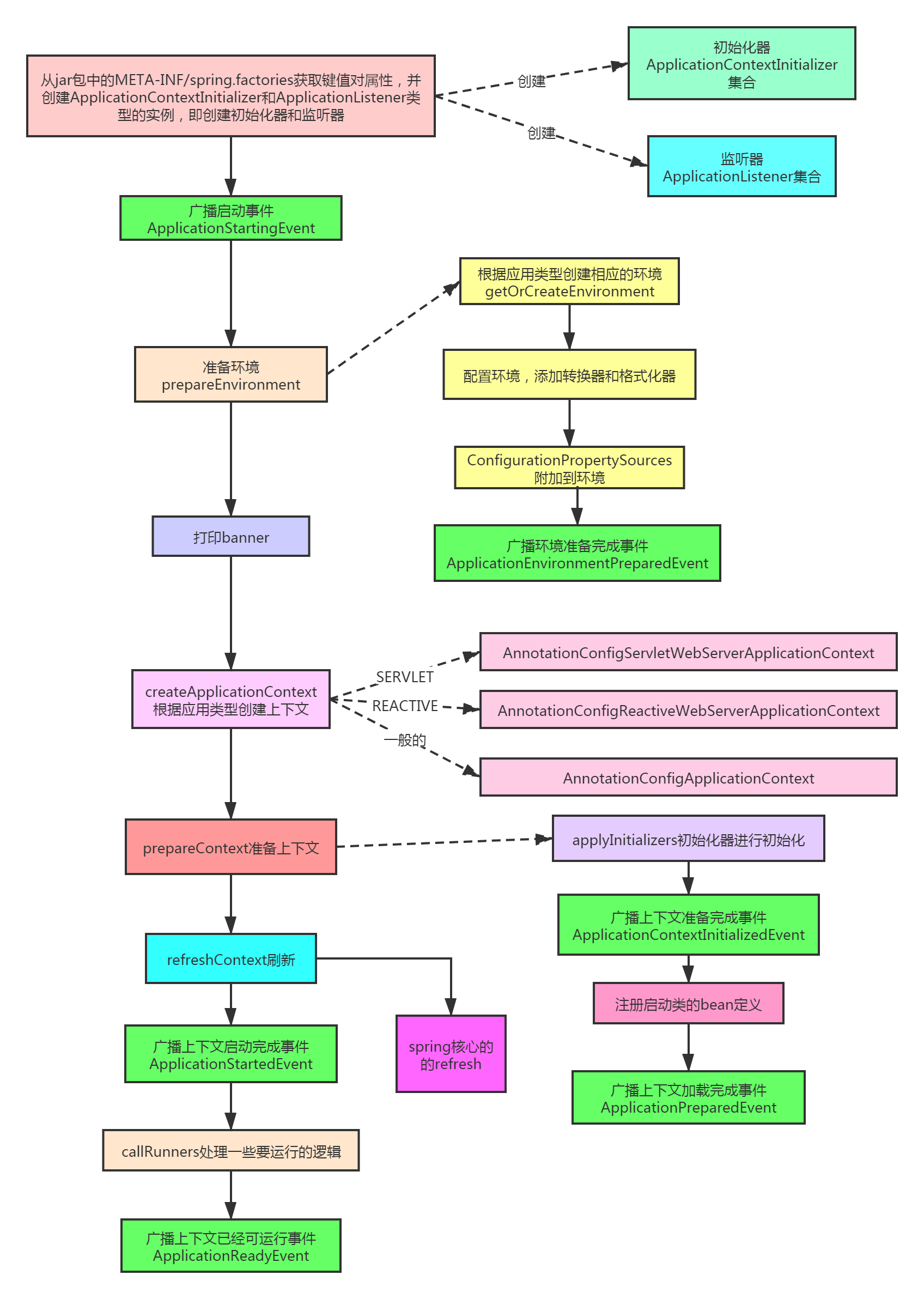
getSpringFactoriesInstances(BootstrapRegistryInitializer.class))(初始化引导注册表初始化器)
我们来看看这一句话做了什么:
this.bootstrapRegistryInitializers = new ArrayList<>( getSpringFactoriesInstances(BootstrapRegistryInitializer.class));package org.springframework.boot;
回调接口,可用于在{@link BootstrapRegistry}使用前对其进行初始化。
/**
* Callback interface that can be used to initialize a {@link BootstrapRegistry} before it
* is used.
*
* @author Phillip Webb
* @since 2.4.5
* @see SpringApplication#addBootstrapRegistryInitializer(BootstrapRegistryInitializer)
* @see BootstrapRegistry
*/
@FunctionalInterface
public interface BootstrapRegistryInitializer {
/**
* Initialize the given {@link BootstrapRegistry} with any required registrations.
* @param registry the registry to initialize
*/
void initialize(BootstrapRegistry registry);
}给SpringApplication这个类的private final List<BootstrapRegistryInitializer> bootstrapRegistryInitializers;这个属性赋值,看看这个getSpringFactoriesInstances方法

实际是调用下面这个,SpringFactoriesLoader.forDefaultResourceLocation(getClassLoader()).load(type, argumentResolver);
forDefaultResourceLocation()方法注释是创建一个 {@link SpringFactoriesLoader} 实例,该实例将加载并实例化来自{@value #FACTORIES_RESOURCE_LOCATION}的工厂实现,使用给定的类加载器

返回一个SpringFactoriesLoader对象,调用的是forResourceLocation,第一个参数是资源目录,资源目录是

getClassLoader()查看当前类加载器

Map<String, SpringFactoriesLoader> loaders = cache.computeIfAbsent( resourceClassLoader, key -> new ConcurrentReferenceHashMap<>());
这段代码的大概意思是从map缓存中获取SpringFactoriesLoader工厂实例,如果指定的键(key)在映射中尚未关联值,则计算该键的值并将其存储在映射中。如果键已经存在,则直接返回现有的值,cache类型为static final Map<ClassLoader, Map<String, SpringFactoriesLoader>> cache = new ConcurrentReferenceHashMap<>();先利用resourceClassLoader获取到Map<String, SpringFactoriesLoader>类型的value,如果value有值的话就返回现在的值,没有的话new ConcurrentReferenceHashMap<>()
return loaders.computeIfAbsent(resourceLocation, key ->
new SpringFactoriesLoader(classLoader, loadFactoriesResource(resourceClassLoader, resourceLocation)));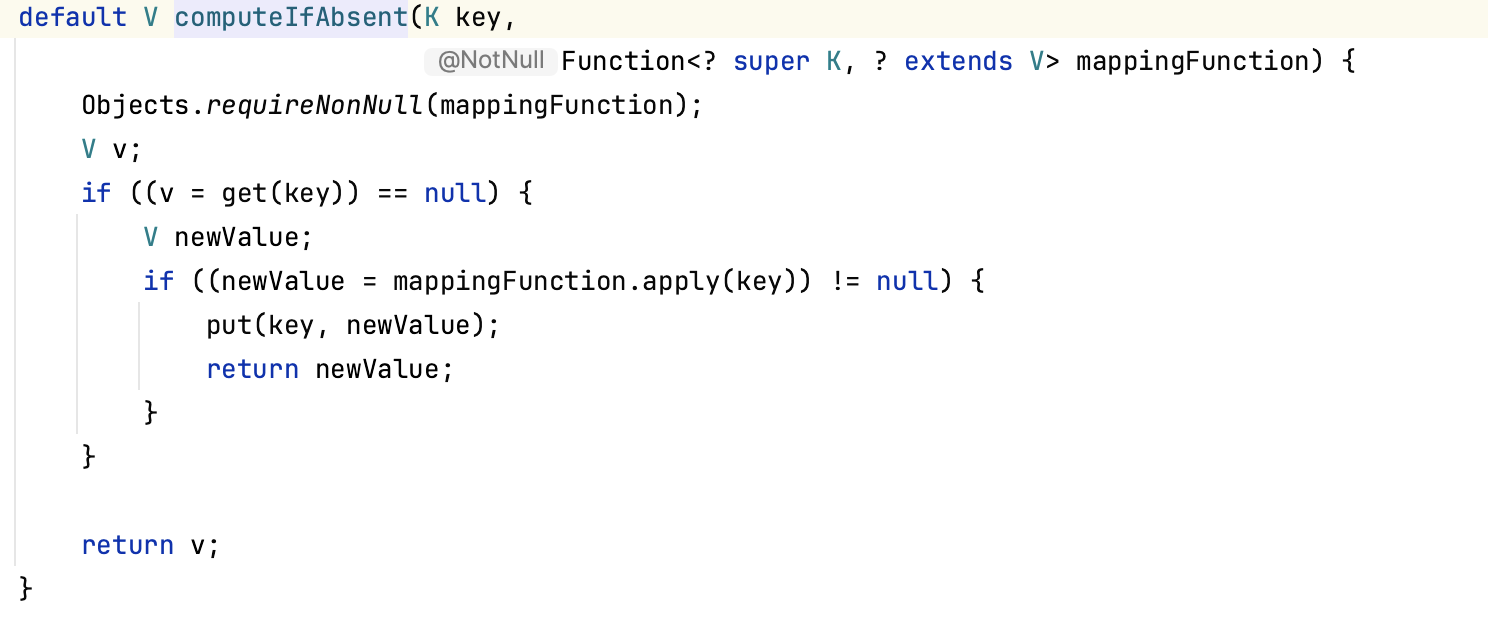
这一步与上面类似,如果对应的key值有value的话就直接返回,没有的话new一个SpringFactoriesLoader,可以看到接收两个参数,一个classloader和一个loadFactoriesResource(resourceClassLoader, resourceLocation)),这个方法的具体方法内容为
protected static Map<String, List<String>> loadFactoriesResource(ClassLoader classLoader, String resourceLocation) {
Map<String, List<String>> result = new LinkedHashMap<>();
try {
Enumeration<URL> urls = classLoader.getResources(resourceLocation);
while (urls.hasMoreElements()) {
UrlResource resource = new UrlResource(urls.nextElement());
Properties properties = PropertiesLoaderUtils.loadProperties(resource);
properties.forEach((name, value) -> {
String[] factoryImplementationNames = StringUtils.commaDelimitedListToStringArray((String) value);
List<String> implementations = result.computeIfAbsent(((String) name).trim(),
key -> new ArrayList<>(factoryImplementationNames.length));
Arrays.stream(factoryImplementationNames).map(String::trim).forEach(implementations::add);
});
}
result.replaceAll(SpringFactoriesLoader::toDistinctUnmodifiableList);
}
catch (IOException ex) {
throw new IllegalArgumentException("Unable to load factories from location [" + resourceLocation + "]", ex);
}
return Collections.unmodifiableMap(result);
}可以轻松看到这是加载springboot jar包下的spring.factories文件

最终结果为19条,但是springboot下面的spring.factories的文件只有15条,这是什么原因呢?
# Logging Systems
org.springframework.boot.logging.LoggingSystemFactory=\
org.springframework.boot.logging.logback.LogbackLoggingSystem.Factory,\
org.springframework.boot.logging.log4j2.Log4J2LoggingSystem.Factory,\
org.springframework.boot.logging.java.JavaLoggingSystem.Factory
# PropertySource Loaders
org.springframework.boot.env.PropertySourceLoader=\
org.springframework.boot.env.PropertiesPropertySourceLoader,\
org.springframework.boot.env.YamlPropertySourceLoader
# ConfigData Location Resolvers
org.springframework.boot.context.config.ConfigDataLocationResolver=\
org.springframework.boot.context.config.ConfigTreeConfigDataLocationResolver,\
org.springframework.boot.context.config.StandardConfigDataLocationResolver
# ConfigData Loaders
org.springframework.boot.context.config.ConfigDataLoader=\
org.springframework.boot.context.config.ConfigTreeConfigDataLoader,\
org.springframework.boot.context.config.StandardConfigDataLoader
# Application Context Factories
org.springframework.boot.ApplicationContextFactory=\
org.springframework.boot.web.reactive.context.ReactiveWebServerApplicationContextFactory,\
org.springframework.boot.web.servlet.context.ServletWebServerApplicationContextFactory
# Run Listeners
org.springframework.boot.SpringApplicationRunListener=\
org.springframework.boot.context.event.EventPublishingRunListener
# Error Reporters
org.springframework.boot.SpringBootExceptionReporter=\
org.springframework.boot.diagnostics.FailureAnalyzers
# Application Context Initializers
org.springframework.context.ApplicationContextInitializer=\
org.springframework.boot.context.ConfigurationWarningsApplicationContextInitializer,\
org.springframework.boot.context.ContextIdApplicationContextInitializer,\
org.springframework.boot.context.config.DelegatingApplicationContextInitializer,\
org.springframework.boot.rsocket.context.RSocketPortInfoApplicationContextInitializer,\
org.springframework.boot.web.context.ServerPortInfoApplicationContextInitializer
# Application Listeners
org.springframework.context.ApplicationListener=\
org.springframework.boot.ClearCachesApplicationListener,\
org.springframework.boot.builder.ParentContextCloserApplicationListener,\
org.springframework.boot.context.FileEncodingApplicationListener,\
org.springframework.boot.context.config.AnsiOutputApplicationListener,\
org.springframework.boot.context.config.DelegatingApplicationListener,\
org.springframework.boot.context.logging.LoggingApplicationListener,\
org.springframework.boot.env.EnvironmentPostProcessorApplicationListener
# Environment Post Processors
org.springframework.boot.env.EnvironmentPostProcessor=\
org.springframework.boot.cloud.CloudFoundryVcapEnvironmentPostProcessor,\
org.springframework.boot.context.config.ConfigDataEnvironmentPostProcessor,\
org.springframework.boot.env.RandomValuePropertySourceEnvironmentPostProcessor,\
org.springframework.boot.env.SpringApplicationJsonEnvironmentPostProcessor,\
org.springframework.boot.env.SystemEnvironmentPropertySourceEnvironmentPostProcessor,\
org.springframework.boot.reactor.ReactorEnvironmentPostProcessor
# Failure Analyzers
org.springframework.boot.diagnostics.FailureAnalyzer=\
org.springframework.boot.context.config.ConfigDataNotFoundFailureAnalyzer,\
org.springframework.boot.context.properties.IncompatibleConfigurationFailureAnalyzer,\
org.springframework.boot.context.properties.NotConstructorBoundInjectionFailureAnalyzer,\
org.springframework.boot.diagnostics.analyzer.AotInitializerNotFoundFailureAnalyzer,\
org.springframework.boot.diagnostics.analyzer.BeanCurrentlyInCreationFailureAnalyzer,\
org.springframework.boot.diagnostics.analyzer.BeanDefinitionOverrideFailureAnalyzer,\
org.springframework.boot.diagnostics.analyzer.BeanNotOfRequiredTypeFailureAnalyzer,\
org.springframework.boot.diagnostics.analyzer.BindFailureAnalyzer,\
org.springframework.boot.diagnostics.analyzer.BindValidationFailureAnalyzer,\
org.springframework.boot.diagnostics.analyzer.InvalidConfigurationPropertyNameFailureAnalyzer,\
org.springframework.boot.diagnostics.analyzer.InvalidConfigurationPropertyValueFailureAnalyzer,\
org.springframework.boot.diagnostics.analyzer.MissingParameterNamesFailureAnalyzer,\
org.springframework.boot.diagnostics.analyzer.MutuallyExclusiveConfigurationPropertiesFailureAnalyzer,\
org.springframework.boot.diagnostics.analyzer.NoSuchMethodFailureAnalyzer,\
org.springframework.boot.diagnostics.analyzer.NoUniqueBeanDefinitionFailureAnalyzer,\
org.springframework.boot.diagnostics.analyzer.PatternParseFailureAnalyzer,\
org.springframework.boot.diagnostics.analyzer.PortInUseFailureAnalyzer,\
org.springframework.boot.diagnostics.analyzer.UnboundConfigurationPropertyFailureAnalyzer,\
org.springframework.boot.diagnostics.analyzer.ValidationExceptionFailureAnalyzer,\
org.springframework.boot.liquibase.LiquibaseChangelogMissingFailureAnalyzer,\
org.springframework.boot.web.context.MissingWebServerFactoryBeanFailureAnalyzer,\
org.springframework.boot.web.embedded.tomcat.ConnectorStartFailureAnalyzer
# Failure Analysis Reporters
org.springframework.boot.diagnostics.FailureAnalysisReporter=\
org.springframework.boot.diagnostics.LoggingFailureAnalysisReporter
# Database Initializer Detectors
org.springframework.boot.sql.init.dependency.DatabaseInitializerDetector=\
org.springframework.boot.flyway.FlywayDatabaseInitializerDetector,\
org.springframework.boot.jdbc.init.DataSourceScriptDatabaseInitializerDetector,\
org.springframework.boot.liquibase.LiquibaseDatabaseInitializerDetector,\
org.springframework.boot.orm.jpa.JpaDatabaseInitializerDetector,\
org.springframework.boot.r2dbc.init.R2dbcScriptDatabaseInitializerDetector
# Depends On Database Initialization Detectors
org.springframework.boot.sql.init.dependency.DependsOnDatabaseInitializationDetector=\
org.springframework.boot.sql.init.dependency.AnnotationDependsOnDatabaseInitializationDetector,\
org.springframework.boot.jdbc.SpringJdbcDependsOnDatabaseInitializationDetector,\
org.springframework.boot.jooq.JooqDependsOnDatabaseInitializationDetector,\
org.springframework.boot.orm.jpa.JpaDependsOnDatabaseInitializationDetector
# Resource Locator Protocol Resolvers
org.springframework.core.io.ProtocolResolver=\
org.springframework.boot.io.Base64ProtocolResolver
回到源码debug一下,发现还加载了autoconfig(9条),aop(1条)
最终结果为19条,是因为去掉了重复项

获取到之后,调用load(type, argumentResolver);这个方法进去
调用load方法,大致说明是:/**
* 从{@value #FACTORIES_RESOURCE_LOCATION}加载并实例化给定类型的工厂实现,使用配置的类加载器和给定的参数解析器。
* <p>返回的工厂通过{@link AnnotationAwareOrderComparator}进行排序。
* <p>从Spring Framework 5.3开始,如果在给定的工厂类型中发现重复的实现类名,只会实例化一个重复实现类型的实例。
* @param factoryType 表示工厂的接口或抽象类
* @param argumentResolver 用于通过类型解析构造函数参数的策略
* @throws IllegalArgumentException 如果任何工厂实现类无法加载,或者在实例化任何工厂时发生错误
* @since 6.0
*/
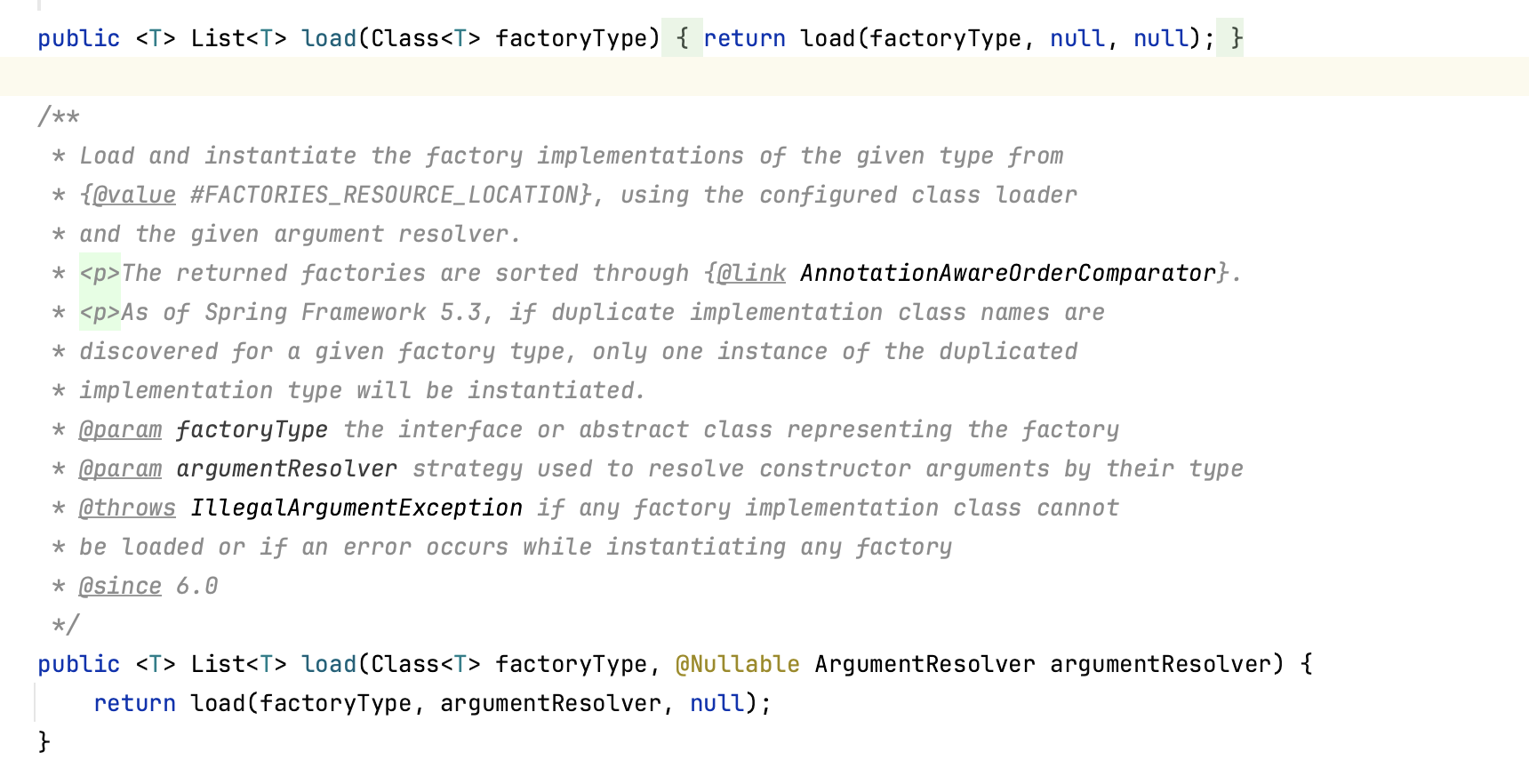
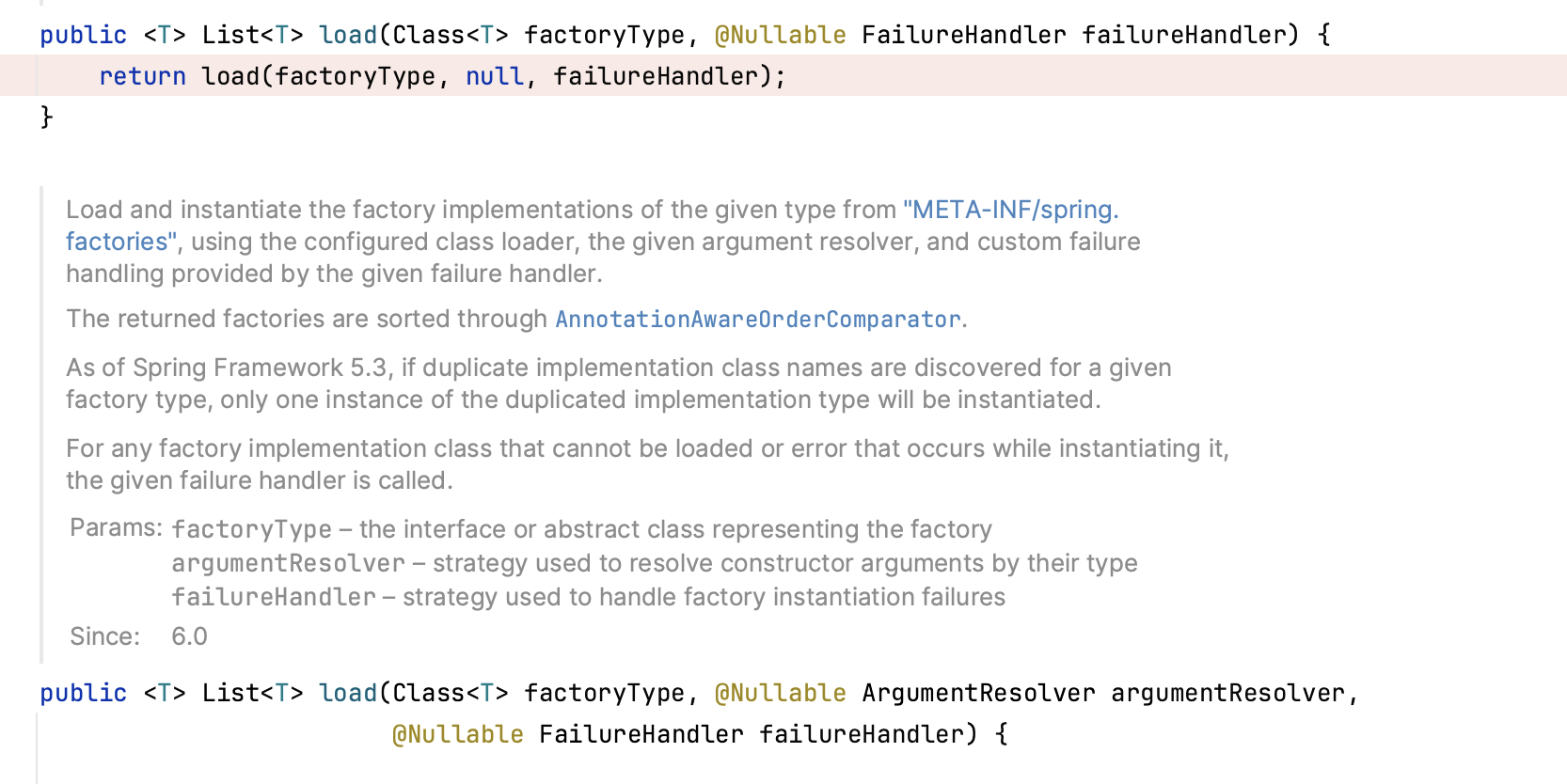
依次调用上面几个方法,debug一下,这里是根据factoryType类型再次筛选,类型为getSpringFactoriesInstances(BootstrapRegistryInitializer.class))这里的BootstrapRegistryInitializer.class,具体筛选方法为loadFactory(),里面调用getOrDefault(),自己查看源码,不做赘述
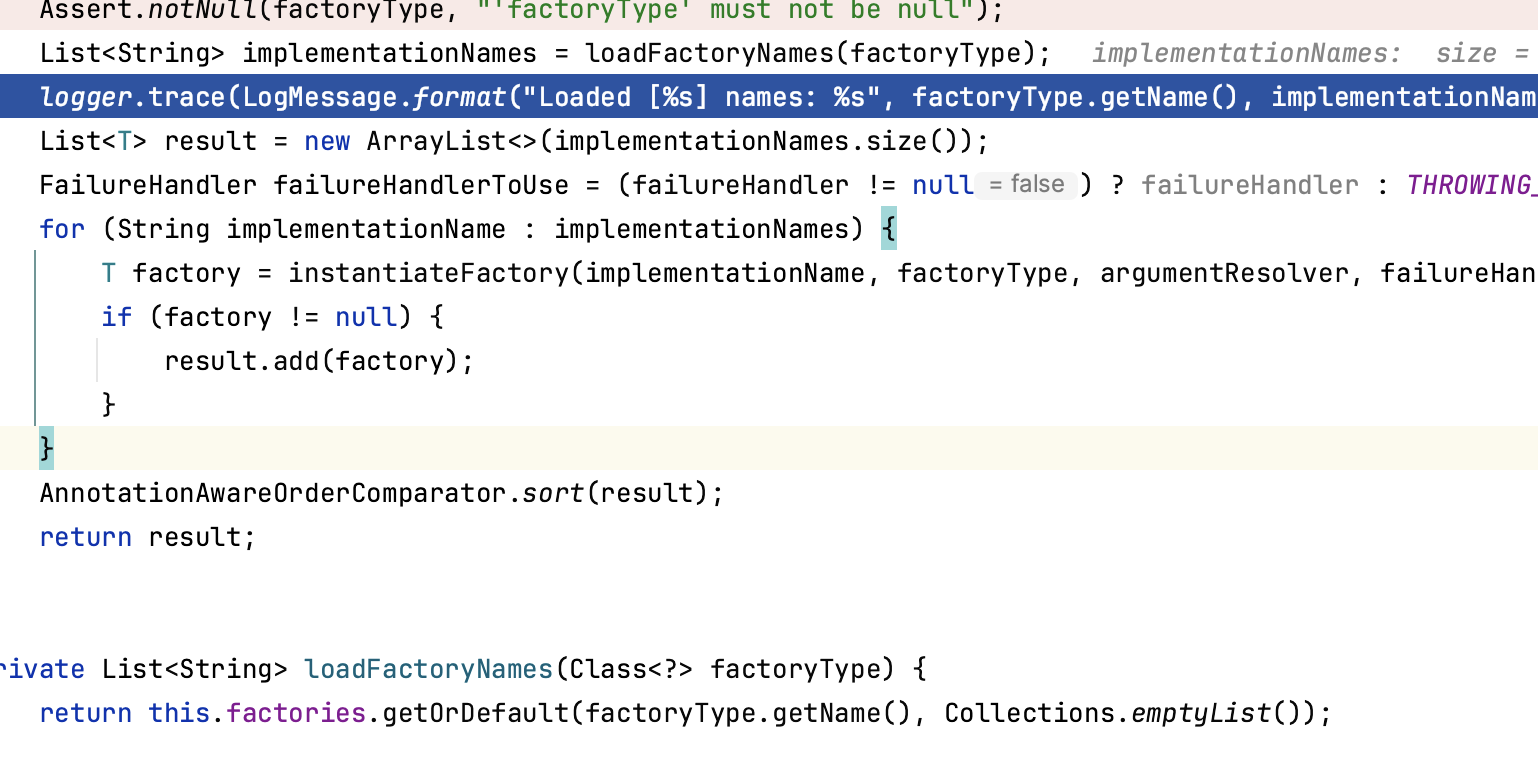
我们通过main方法调用一下由于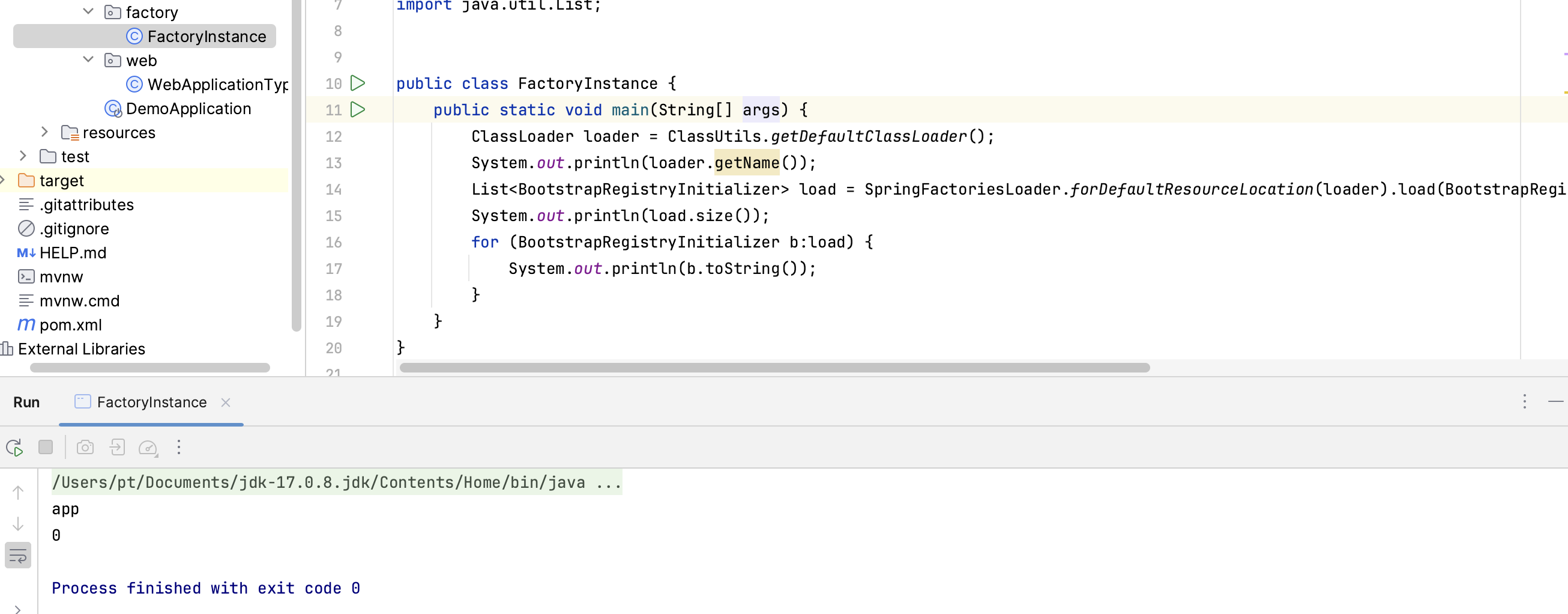
由于我们没有实现给定的类型的类加载器,所以size为0;
setInitializers((Collection) getSpringFactoriesInstances(ApplicationContextInitializer.class));(设置应用上下文初始化器)
这个与上面类似,给private List<ApplicationContextInitializer<?>> initializers属性赋值,也是加载工厂,只不过类型为ApplicationContextInitializer<?>这个接口进去看一下
回调接口,用于在Spring的{@link ConfigurableApplicationContext}被{@linkplain ConfigurableApplicationContext#refresh()刷新}之前进行初始化。
* <p>通常用于需要对应用程序上下文进行一些程序化初始化的Web应用程序。例如,对{@linkplain ConfigurableApplicationContext#getEnvironment()上下文的环境}注册属性源或激活配置文件。参见{@code ContextLoader}和{@code FrameworkServlet}支持声明"contextInitializerClasses"上下文参数和init-param。
* <p>鼓励{@code ApplicationContextInitializer}处理器检测是否实现了Spring的{@link org.springframework.core.Ordered Ordered}接口,或者是否存在{@link org.springframework.core.annotation.Order @Order}注解,并在调用前相应地对实例进行排序。
* @author Chris Beams
* @since 3.1
* @param <C> 应用程序上下文类型
* @see org.springframework.web.context.ContextLoader#customizeContext
* @see org.springframework.web.context.ContextLoader#CONTEXT_INITIALIZER_CLASSES_PARAM
* @see org.springframework.web.servlet.FrameworkServlet#setContextInitializerClasses
* @see org.springframework.web.servlet.FrameworkServlet#applyInitializers

执行过程与上面一样,只不是工厂接口不一样,不做赘述,我们也用main方法测试一下
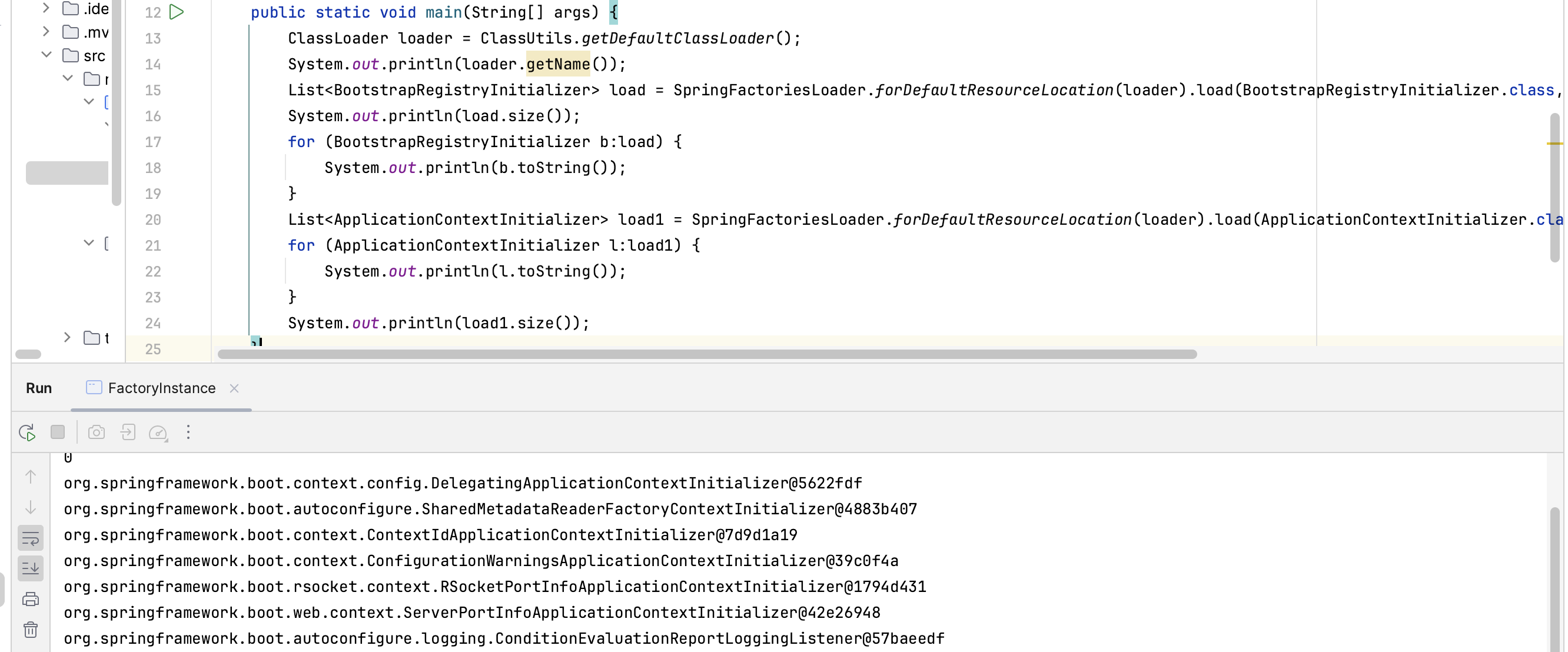
这次运行有七个spring工厂实例
这里是对每个实例的简要说明:
1. `org.springframework.boot.context.config.DelegatingApplicationContextInitializer@5622fdf`:
- 这个初始化器负责将Spring Boot的`ApplicationContext`代理给Spring的原生`ConfigurableApplicationContext`。这允许在Spring Boot应用中使用Spring框架的原生功能。
2. `org.springframework.boot.autoconfigure.SharedMetadataReaderFactoryContextInitializer@4883b407`:
- 这个初始化器确保所有上下文共享同一个`MetadataReaderFactory`实例,这是Spring用来读取类元数据的工厂。
3. `org.springframework.boot.context.ContextIdApplicationContextInitializer@7d9d1a19`:
- 这个初始化器设置应用上下文的ID,通常是从`application.properties`或`application.yml`配置文件中读取的。
4. `org.springframework.boot.context.ConfigurationWarningsApplicationContextInitializer@39c0f4a`:
- 这个初始化器负责在启动时打印出关于配置问题的警告,例如不推荐的配置属性。
5. `org.springframework.boot.rsocket.context.RSocketPortInfoApplicationContextInitializer@1794d431`:
- 如果你的应用使用了Spring Boot的RSocket支持,这个初始化器会在启动时注册RSocket服务器的端口信息。
6. `org.springframework.boot.web.context.ServerPortInfoApplicationContextInitializer@42e26948`:
- 这个初始化器会在启动时注册Web服务器的端口信息,例如Tomcat的端口。
7. `org.springframework.boot.autoconfigure.logging.ConditionEvaluationReportLoggingListener@57baeedf`:
- 这个监听器用于在启动时记录条件评估报告,这有助于调试自动配置的条件。
这些实例不是“奇怪”的,而是Spring Boot框架的一部分,它们在应用启动时提供了额外的初始化逻辑。这些初始化器和监听器通过`META-INF/spring.factories`文件注册,Spring Boot在启动时会自动加载它们。每个实例后面的`@xxxx`是对象的哈希码,用于唯一标识实例。
setListeners((Collection) getSpringFactoriesInstances(ApplicationListener.class));(设置事件监听器)
事件监听器
应用事件监听器需要实现的接口。
* <p>基于标准的{@link java.util.EventListener}接口,用于观察者设计模式。
* <p>{@code ApplicationListener}可以泛型声明它感兴趣的事件类型。当注册到Spring的{@code ApplicationContext}时,事件将相应地进行过滤,只有匹配的事件对象才会触发监听器的调用。
* @author Rod Johnson
* @author Juergen Hoeller
* @param <E> 要监听的特定{@code ApplicationEvent}子类的类型
* @see org.springframework.context.ApplicationEvent
* @see org.springframework.context.event.ApplicationEventMulticaster
* @see org.springframework.context.event.SmartApplicationListener
* @see org.springframework.context.event.GenericApplicationListener
* @see org.springframework.context.event.EventListener
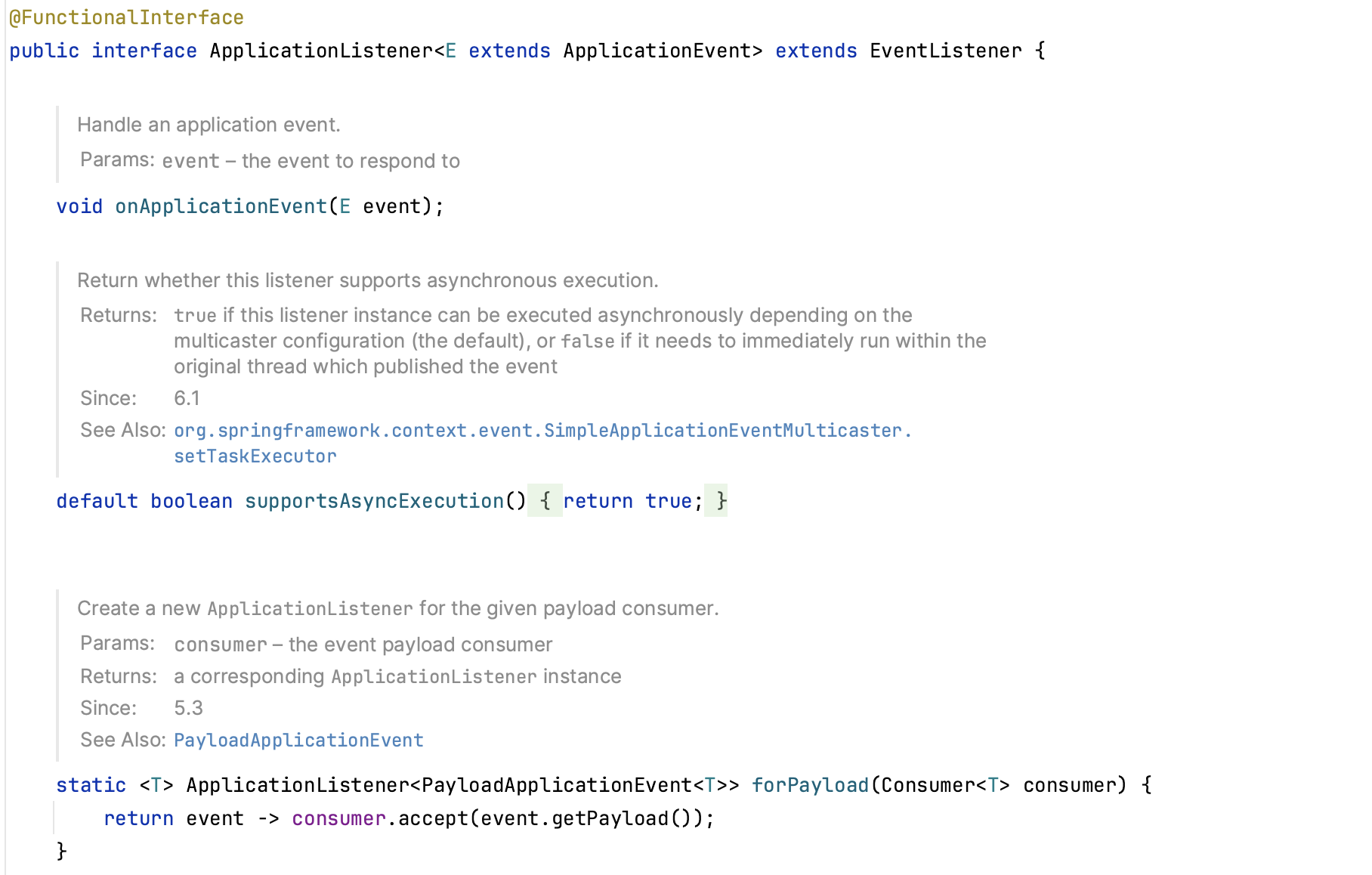
运行main方法看一下,有8个
List<ApplicationListener> load2 = SpringFactoriesLoader.forDefaultResourceLocation(loader).load(ApplicationListener.class, (SpringFactoriesLoader.ArgumentResolver) null);
for (ApplicationListener l:load2) {
System.out.println(l.toString());
}
System.out.println(load2.size());
这些是Spring Boot中实现`ApplicationListener`接口的事件监听器的实例,每个实例都用于处理Spring应用上下文中的不同事件。以下是每个监听器的简要说明:
1. `org.springframework.boot.env.EnvironmentPostProcessorApplicationListener@6325a3ee`:
- 这个监听器用于在Spring环境准备完成后,但在应用上下文刷新之前,对环境进行额外的处理。
2. `org.springframework.boot.context.config.AnsiOutputApplicationListener@1d16f93d`:
- 这个监听器处理ANSI输出设置,确保控制台输出的颜色和格式化在不同的操作系统上都能正确显示。
3. `org.springframework.boot.context.logging.LoggingApplicationListener@67b92f0a`:
- 这个监听器用于在应用启动时初始化日志系统,并在应用关闭时清理日志系统。
4. `org.springframework.boot.autoconfigure.BackgroundPreinitializer@2b9627bc`:
- 这个监听器用于在Spring Boot应用启动前预初始化一些背景任务,以加快启动速度。
5. `org.springframework.boot.context.config.DelegatingApplicationListener@65e2dbf3`:
- 这个监听器可能是用于代理其他监听器的事件处理,以便在不同的上下文中应用相同的事件处理逻辑。
6. `org.springframework.boot.builder.ParentContextCloserApplicationListener@4f970963`:
- 这个监听器确保在关闭子应用上下文时,其父上下文也会被正确关闭。
7. `org.springframework.boot.ClearCachesApplicationListener@61f8bee4`:
- 这个监听器用于在应用上下文刷新后清除Spring框架内部的一些缓存,以减少内存占用。
8. `org.springframework.boot.context.FileEncodingApplicationListener@7b49cea0`:
- 这个监听器用于设置文件编码,确保文件读写操作使用正确的字符编码。
this.mainApplicationClass = deduceMainApplicationClass();
这里就是推断启动类的,直接抛出异常,然后找到main方法所在的类,用于推断Spring Boot应用的主程序类。这个方法会检查各种线索,如传递给SpringApplication.run()方法的参数、应用的类路径等,以确定哪个类包含main方法
private Class<?> deduceMainApplicationClass() {
return StackWalker.getInstance(StackWalker.Option.RETAIN_CLASS_REFERENCE)
.walk(this::findMainClass)
.orElse(null);
}返回一个具有指定选项的`StackWalker`实例,该选项确定它可以访问的栈帧信息。
* <p>
* 如果存在安全管理器,并且给定的`option`是{@link Option#RETAIN_CLASS_REFERENCE Option.RETAIN_CLASS_REFERENCE},它会调用其{@link SecurityManager#checkPermission checkPermission}方法,传入{@code RuntimePermission("getStackWalkerWithClassReference")}。
* @param option 栈遍历选项{@link Option}
*
* @return 配置了给定选项的`StackWalker`
*
* @throws SecurityException 如果存在安全管理器,并且其`checkPermission`方法拒绝访问权限。
public static StackWalker getInstance(Option option) {
return getInstance(EnumSet.of(Objects.requireNonNull(option)));
}
public static StackWalker getInstance(Set<Option> options) {
if (options.isEmpty()) {
return DEFAULT_WALKER;
}
EnumSet<Option> optionSet = toEnumSet(options);
checkPermission(optionSet);
return new StackWalker(optionSet);
}